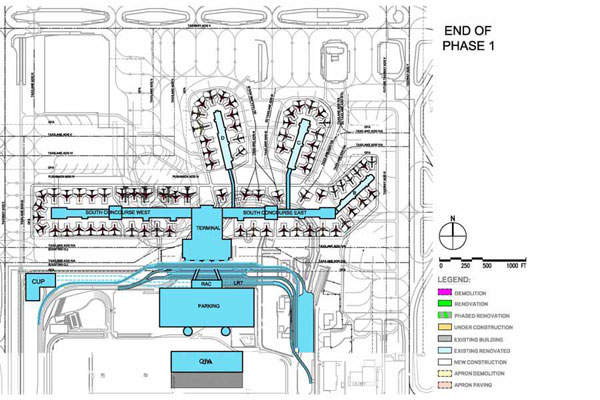
Salt Lake City International Airport is being redeveloped and modernised under a terminal redevelopment project (TRP) launched in January 2012. The TRP project will be implemented in three stages. Construction for the initial phase will begin in 2014 and the project is expected to be completed by 2026. Salt Lake City airport, managed and operated by the Salt Lake City Department of Airports (SLCDA), handled about 20 million passengers in 2013.
Related content
Salt Lake City International Airport Terminal and Airfield Upgrade
Salt Lake City International Airport (SLCIAP) is situated west of Salt Lake City, about ten minutes from the downtown area.
The terminal redevelopment project is being implemented to minimise seismic risks at the airport. The airport terminals and the concourses building, which have been operating for the past 27 to 50 years, have become outdated calling for a major redevelopment. The new terminal, to be built at an estimated cost of $1.8bn, will provide better customer service and accommodate more passengers.
Construction plan for Salt Lake City airport
Stage one will include construction of the new terminal and the west side of the new concourse, and renovation of Concourse A. A rental car transaction building, a consolidated rental car quick turn-around (QTA) facility, a new central utility plant (CUP) and new roadways will be also constructed.
Stage two will include construction of the east side of the new concourse, installation of new connectors between concourses C and D, and renovation of Concourse B. Stage three will include demolition of Concourse A and renovation of the existing concourses C and D.
Details of the terminal redevelopment programme
The redevelopment project will include construction of a new terminal, a new concourse and other support facilities, rehabilitation of Concourses B, C, & D, and improvement of roadways and associated infrastructure.
The existing terminals one and two, and other buildings such as the existing parking garage and the International Arrivals Building will be demolished to create space for the new terminal and the associated facilities. The new concourse will be located east of the new terminal, will feature 13 gates and will be connected to the existing concourses. The renovated concourses will feature a built up space of one million square feet.
The rental car transaction building to be located on the north side of the parking area will feature two-levels. The lower level will provide space for rental car counters and offices, whereas the upper level will feature the entrances to two pedestrian bridges to the terminal and self-serve check-in kiosks. The Utah Transit Authority’s (UTA) airport light rail station will be relocated to the car rental building. The station will be designed and financed by the UTA.
The QTA facility, which will provide car cleaning, servicing and storage, will be constructed on south of the new parking garage for rental cars.
The new CUP plant, to be located west of the new parking garage, will be equipped with heating, cooling and standby power systems. It will feature more sophisticated systems than those of the existing plant.
A new parking garage featuring five-levels and about 3,600 parking spaces will be constructed in 2016. The new roadway system will separate the arriving and departing areas, which are combined at the existing terminal.
Features of the new terminal at the Salt Lake City airport
The new terminal will be located to the west of the existing short-term parking terrace and will cover about 700,000ft2 accommodating up to 75 aircraft gates. The terminal will be designed with three levels and will be connected to the existing concourses A, B, C and D.
Level one of the terminal will feature passenger pick-up, international baggage claim, employee security screening and baggage-handling areas, while level two will feature pedestrian bridges connected to the parking terrace and the roadway system, passenger drop-off facility, and access to the concourses and retail areas. Level three will provide space for airport administration offices, airline ticketing and check-in counters.
The new building will be designed to high environmental standards and will be equipped with advanced technological systems. It is expected to receive the silver certification in leadership in energy and environmental design (LEED) from the US Green Building Council.
Contractors involved with the TRP project
CH2M HILL is performing the environmental impact assessment (EIA) of the project in co-operation with Leigh Fisher. HOK Architects is the master architect and engineer for the project. MHTN Architects, GSBS Architects, FFKR Architects and Architectural Nexus will serve as associate architects.
The Holder-Big-D Construction (HD) consortium was selected as the construction manager at risk (CMAR) in November 2013, to provide preconstruction and construction services for the terminal redevelopment. The consortium includes holder construction company (Holder) and Big-D Construction with the former acting as the managing partner.
Colvin Engineering, Envision Engineering and Van Boerum & Frank Associates are the mechanical, electrical and plumbing engineers. The structural engineers are Dunn Associates and Reaveley Engineers. URS Corporation, JUB Engineers, CH2MHill, Horrocks Engineers and RB & G Engineering are the civil engineers for the project.










